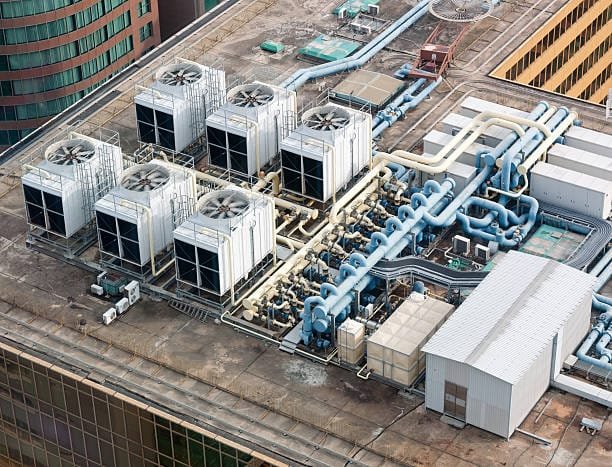
DUCT AIR CONDITIONING SYSTEM IN CHENNAI
Duct Air Conditioning System
A duct air conditioning system is a centralized cooling solution that uses a network of ducts to distribute cool air evenly across multiple rooms or areas. It consists of a main air conditioning unit connected to rigid and flexible ducts, which channel the air to various spaces through vents or diffusers. This system is commonly used in both residential and commercial buildings for its ability to maintain consistent indoor temperatures while remaining out of sight.
Duct Air Conditioning System

Centralized Air Conditioner
A Centralized Air Conditioner serves as the heart of a ducted air conditioning system, typically installed in a dedicated area such as the rooftop, basement, or mechanical room. This location minimizes noise and maximizes the system’s efficiency. The central unit cools the air and is connected to a network of ducts that distribute the conditioned air throughout the entire building.

Cooling Process
The Cooling Process starts when warm air is drawn from the rooms through return ducts. This air passes over the evaporator coil, where heat is absorbed by the refrigerant inside the coil, cooling the air and removing excess humidity. Once cooled, the air is pushed back into the rooms through supply ducts, maintaining a comfortable environment. The efficiency of this process is key to the overall performance of the ducted air conditioning system.

Air Distribution Through Ducts
Air Distribution Through Ducts involves a system of rigid ducts, which are the primary channels for transporting the cooled air from the central unit to multiple rooms. Flexible ducts are then used to connect the rigid ducts to the vents or diffusers in each room, ensuring the cool air reaches every corner of the building. This efficient air distribution system ensures that the temperature remains consistent across all spaces.

Temperature Control and Zoning
Temperature Control and Zoning are crucial for maintaining comfort and energy efficiency. A thermostat in the system regulates the temperature by controlling the operation of the central air conditioner, ensuring that each room maintains the desired temperature. Many modern systems also include zoning features, which allow different areas of the building to be cooled to different temperatures, offering more control and reducing energy waste by only cooling occupied zones.
Components of a Ducted Air Conditioning System
A ducted air conditioning system consists of several key components that work together to provide efficient cooling. Here’s a breakdown of the main parts.
Rigid Ducts
• Rigid ducts are the largest components in a ducted air conditioning system.
• They are typically made of galvanized iron with a thickness of 0.5mm to 1.0mm, depending on the size of the duct.
• To prevent condensation and maintain efficiency, the ducts are insulated.
Ducted Air Conditioner
• The ducted air conditioner includes units like fan coil units or air handling units.
• These units are designed to distribute air through the ductwork.
• They have higher fan power (static pressure) to push air effectively through the ducts and into the rooms.
Insulation
• Insulation plays a crucial role in the system’s efficiency.
• It prevents cold air inside the ducts from warming up as it travels through the system.
• Without proper insulation, the air can lose its coolness before reaching the supply vents, reducing the system’s performance.
Flexible Ducts
• Flexible ducts are soft, insulated, and bendable, making them ideal for connecting rigid ducts to vents, return air grilles, or diffusers.
• These are typically used for the final connections and provide installation flexibility.
• While useful, not all ducted systems require flexible ducts.
Each of these components plays a vital role in ensuring that the ducted air conditioning system operates efficiently, delivering cool and comfortable air to all parts of the building.
Why Use a Duct Air Conditioning System?

Uniform Cooling
Delivers consistent cooling across all connected rooms, ensuring optimal comfort.

Aesthetic Appeal
The system is discreetly installed with hidden ducts, leaving no visible units to interfere with the interior design of the space.

Energy Efficiency
Operates with a single unit for multiple rooms, reducing energy consumption compared to individual air conditioners.

Cost-Effective Maintenance
A Centralized setup simplifies maintenance compared to managing multiple stand-alone systems.

Improved Air Quality
Equipped with advanced filters to remove dust, allergens, and pollutants, ensuring healthier indoor air.

High Cooling Capacity
Suitable for large spaces, making it an ideal choice for commercial buildings and offices.
Benefits of Choosing a Duct Air Conditioning System
A duct air conditioning system is an excellent solution for those seeking efficient, aesthetic, and reliable cooling solutions for their residential or commercial spaces.
- Seamless integration into interior designs.
- High cooling efficiency for large spaces.
- Healthier indoor air with advanced filtration.
- Quiet operation due to the remote placement of the air conditioning unit.
Why Choose a Ducted Air Conditioning System in Chennai?

Weather Suitability
Designed to handle Chennai’s warm and humid climate, providing reliable cooling solutions.

Aesthetic Integration
Ideal for modern homes and offices that prioritize minimalist and clutter-free interiors.

Professional Expertise
Chennai-based dealers and distributors offer end-to-end installation, maintenance, and customized solutions.
Applications of Ducted Air Conditioning Systems
Residential Applications
Educational Institutions
Healthcare Facilities
Industrial Applications
Commercial Applications
Frequently Asked Questions?
1. How does a ducted air conditioning system work?
The system works by pulling warm air into the central unit, where it is cooled and dehumidified. The cooled air is then distributed through a series of ducts and vents to various rooms. A thermostat controls the temperature to maintain a comfortable environment
2. Is a ducted air conditioning system energy-efficient?
Yes, ducted systems can be energy-efficient, especially when properly designed, installed, and maintained. The system can be more efficient than individual room air conditioners, particularly when cooling large areas or entire homes.
3. Can I control the temperature in different rooms?
Yes, ducted air conditioning systems can include zoning features, allowing you to control the temperature in different areas of the building. This is ideal for multi-room spaces or large homes, providing customized comfort and reducing energy consumption.
4. What is the maintenance required for a ducted air conditioning system?
Regular maintenance is necessary to ensure the system operates efficiently. This includes cleaning or replacing filters, checking the refrigerant levels, inspecting the ducts for blockages, and servicing the main unit. Professional servicing is recommended at least once a year.
5. Is ducted air conditioning suitable for small homes?
While ducted systems are ideal for large spaces, they can also be installed in smaller homes, though they might be less cost-effective than other types of air conditioning systems. Zoning options can still be used to control airflow in specific areas of a smaller home.
6. Can a ducted system be installed in an existing home?
Yes, ducted air conditioning systems can be retrofitted into existing homes, though it may require significant modifications to the structure, such as installing ducts in ceilings or floors. Professional consultation is needed for retrofitting to ensure feasibility and efficiency.
7. What type of filters are used in ducted air conditioning systems?
Ducted systems typically use high-efficiency filters that help remove dust, allergens, and other particles from the air. These filters improve air quality and ensure that the air circulating through the system is clean and fresh.
8. How long do ducted air conditioning systems last?
With proper maintenance, a ducted air conditioning system can last between 10 to 15 years. Regular servicing and timely repairs can help extend the lifespan of the system.
Reach Out and Let’s Make Things Happen
Contact us today to discuss your industrial ventilation requirements in Chennai and beyond!
